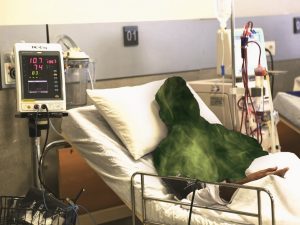A study of Social psychology and steps to redress it
Hepatitis C is not a disease but package; it brings mystery and misery to the family and death to the patient. Hepatitis (B and C combined) has been estimated to cost 150,000 lives every year. Few studies have shown that 10 million people are infected with Hepatitis C in Pakistan and no studies are done to show how many are affected. Gradually, it has shortened our life expectancy; and taking advantage of our crippled health care system attacked our social psychology. Because, new entities in a society, if not entertained and understood well, soon grow into myths. Myths change into beliefs and beliefs are difficult to challenge, may be impossible.
Table of Contents
Complex Phenomenon
Behavior is a complex phenomenon in its formation and appearance, whether at the level of a person or society. As an intricate plot of our perceptions, imaginations, memory, and ideas it reflects as well as affects socio-psychological structure. Arrival of a new disease in a society stirs the social machine in a somewhat similar manner, and results in the development of specific behaviors towards the disease after following a chain of events: First comes its news, then disease itself, then it spreads along with its rumors; patient suffers from illness, family from distress and neighbors from fables. Then, discussions grow, and along with new commentaries form a web; this web is then strengthened with conclusions, ornamented with suggestions, and entraps society as a belief. One of such disease is Hepatitis C.
Hepatitis is not a new entity in the subcontinent area. Hakims and preachers of all sorts of cures for millennia, and physicians for almost a century, are dealing with this entity, unfortunately not with much success let alone improvement; one major change is the method of counting post-infectious days: using calendar instead of tree leaves. Not influenced by our stagnation, Hepatitis continued to grow and introduced a new member in the clan, Hepatitis C, which is not only deadly like other members but also very dreadful. Its natural course can be best studied in a medical library, but to study its afflictions we need to discuss the course (natural or unnatural) of the patient. This method may not tell a lot about disease itself, but will greatly help us to understand our patients and explore the terminologies and myths associated with Hepatitis C in a new light.
Although tortuous, this course can be easily followed: Unfortunately, patient gets sick, tries to heal himself with spiritual powers, first of his own, then elderly family member’s, and then neighbor’s if needed. Disappointed, he goes to the doctor who tries his well accepted formulas (steroids); despite feeling healthy with his body, patient feels sick with his vision as he sees all black in the toilet — possibly the reason behind its notorious name “Black Hepatitis”, although some involvement of black magic can not be completely ruled out—, scared, thus, by the side effect of medicine or of physician, he goes back and is given reassurance as well as a list of lab tests. Positive results bring such a huge a transition in patients course of illness that it deserves a comprehensive review.
A series of events cross patient’s imagination: First of all patient believes that allopathic treatment is very expensive; furthermore it comes with side effects, already dominating his mind more than the benefits, and further consolidated with the experience shared by one of his neighbors or coworkers, who might have talked about the results of treatment, but never missed an opportunity to explain the side effects, and that too in good detail. Finally, suppressing his aforementioned thoughts, overcoming the general mistrust on allopathic medicine (or perhaps physicians) implored by some of the family members, he decides to see the doctor again. Somehow, this opportunity is missed by both physician and patient and he makes his mind not to come back right after physician’s first few sentences, sentences which are more condensed with immediacy and cost of treatment regardless of whether patient wants it or not and for what. A common one I would like to share which is part of all physicians’ conversation with their patients these days “you are already too late, we should start treatment right now”. I believe this is the only part of discussion where the word “we” is heard in allopathic encounters in Pakistan. With no other option left, patient ends up — in most cases ends — with Hakim.
Hakim’s clinic
Hakim’s clinic is a kind of one-stop-shop for patients. Hakim provides the patient with all he needs at this time of sickness and vulnerability. Cheap treatment; satisfying remarks; reassurance of 100% results — provided one of them will live long enough — along with successful stories of patients treated by him; reminder to the patient that only God can bring death to him not the Hepatitis C (not at all Hakim himself); and most significant of all money back guarantee, which patient at this moment does not believe ever to claim — whether because of his 100% chance of being cured or 100% chance of being dead, we don’t know—; is all that helps remove physician from the equation, which now consist of patient and Hakim only. This equation takes many pages of his life to solve, always subtracting health, always adding illness, always dividing happiness, and always multiplying misery, resulting in the end product of death.
A long walk starts with first step
After accomplishing the art of criticizing others, now it is time to reflect on ourselves. We are not supposed to wait for supernatural forces to come as they are already residing inside. We just have to motivate them and let them work. Starting work on a community level can make a substantial difference not only in patients’ and community’s health but also in our spiritual health. Treatment for hepatitis C is currently established beyond doubt: research has proved it, doctors have used it, and patients have accepted it. As individuals we can take steps at community level. Here are few suggestions that can be easily followed:
First of all we have to admit, not to criticize them but to awake ourselves, that our public health department in general and medical community in particular have terribly failed in their duty. Waiting for their help is futile.
Then we have to start working at very basic level. Discourage Hakims as much as we can, at every level of discussion, on every encounter, with every argument possible. Doing this may break the bondage between Hepatitis C and Hakim because either of them is less dangerous than their combination. A person destined to die in a decade by the miseries of hepatitis C can meet his end in weeks with the blessings of Hakim. Failed cases in our families and neighborhoods should be shared in those discussions.
We should always demand proof in successful cases, if any seen.
Culture of Social Interaction
Our beautiful culture of social interaction at town level, adeptly exploited by Hakims, can be used to our population’s benefit by sharing information about new medical treatments at such level. Question can be raised that who listens to anyone anymore. But evidence is contrary to such claims: read the news about the killing of females on words from a neighbor and killing of fellow Muslim, let alone other religious minorities, on words of Mullah. A nation who can afford such adventures on others’ calls is supposed to listen to you as well.
We can make inexpensive screening camps at town level. After that needed population can be helped with appropriate treatment.
Maintaining the records
Maintaining the records, both of results and patients remarks, we can educate and encourage future patients about the promising results of new medical treatments.
Treatment in Pakistan
Pakistan has achieved access to the latest successful treatment of Hepatitis C. Although it is expensive more than the life of our people as per news paper standard, but promising. We should arrange funds at community level for arranging treatment of underprivileged patients and education of all patients.
As patient population infected with Hepatitis C is mostly uneducated (even unable to write their name), because they belong to the lower part of inequality equation of social injustice currently employed in Pakistan, we have to help them arrange their paperwork and maintain their health.
False and faulty starts are no excuses to continue our mistakes. If we love our families, our neighbors, our community; If we want to give our kids a healthy future free of this killer; if we want a to protect our nation from this nasty disease and damaging behaviors that accompany it, then we have to correct our direction. Our failure to prevent our people, not only from hepatitis C but also from hakims, calls into question our half hearted work, if done any, and demand an honest effort to redress our mistakes. We need research not only to understand the epidemiology of the disease but how it affects our social psychology. It is as inexcusable not to study some aspects of a disease, particularly its psychological, social and economic components, as not to study it at all. Myths associated with Hepatitis C — in particular it is curable by Hakims — should be particularly and thoroughly studied and all dots should be linked to come to a solution so that we can untangle us form its web.
Habitually, as we know, our actions are always out numbered by slogans. Here are few commonly used in campaigns for the awareness of Hepatitis C: “it must end”, “ situation must change”, “Quackery should be dealt with iron hands”, and our national one for 2014 “ Know it , confront it”. Campaigns need slogan, actions need man. Actions at all levels. At a national platform, we need to do more studies to explore the underlying factors forcing our patients to seek help from Hakims than doctors. At a local level we should focus on community education and awareness. At both forums physician can play a significant role as well as laymen.











